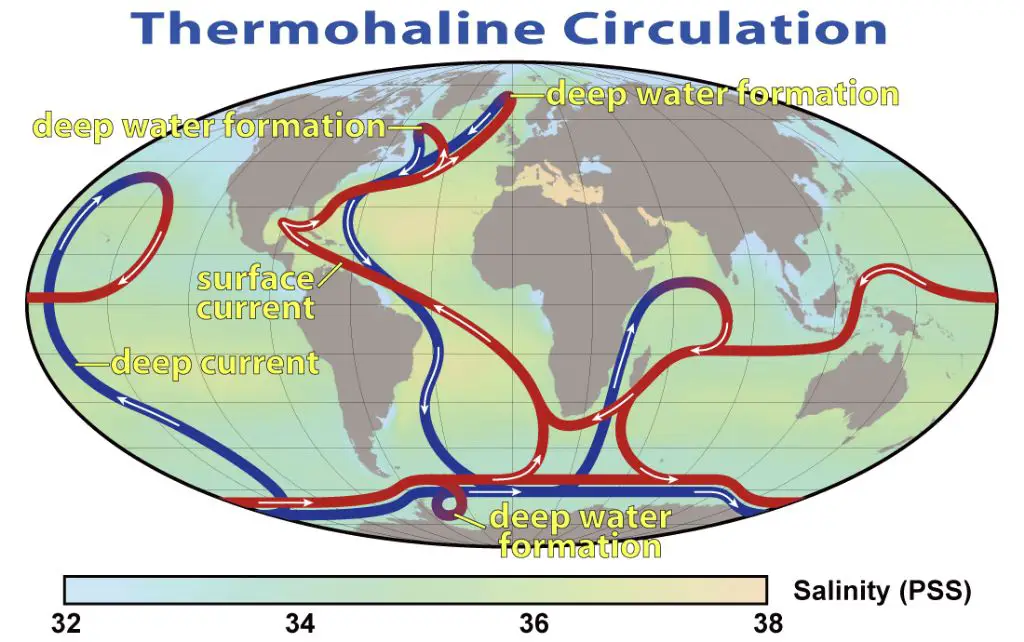What Drives The Motion Of The Ocean?
The motion of the ocean is complex and dynamic, driven by a combination of forces. Oceans are in constant flux, with currents and waves transporting huge amounts of water and energy around the globe. There are five primary forces that drive ocean circulation: wind, the Earth’s rotation (Coriolis effect), water density differences, tides, and the shape of the ocean basins. In this article, we will explore each of these key factors that set the ocean in motion.
Briefly, wind blowing across the sea surface drives surface currents through friction. The Earth’s rotation causes moving objects like currents to be deflected, creating rotating gyres in each ocean basin. Variations in water temperature and salinity affect density, causing denser waters to sink and less dense waters to rise, powering the global overturning circulation. The gravitational forces of the Moon and Sun cause the regular rise and fall of tides. And the shape of ocean basins and configuration of continental landmasses constrain ocean currents. Together, these interconnected forces drive the endless motion of currents, waves, and tides that characterize the global ocean.
Tides
The moon is the primary cause of tides on Earth. The moon’s gravitational pull generates the tidal force, which causes ocean water to be pulled towards the moon. This creates a high tide on the side of Earth closest to the moon and another high tide on the opposite side, with corresponding low tides in between.
There are typically two high tides and two low tides each day. The moon orbits around Earth every 27 days, so after a high tide, the next high tide arrives about 12 hours and 25 minutes later. The timing is about 50 minutes later each day. During a full or new moon, the sun, Earth and moon are aligned, causing even higher than normal tides known as spring tides. During a first or last quarter moon, the sun and moon are at right angles to each other, causing lower than normal tides known as neap tides.
Other factors like weather, winds, and the geography of the local coastline also impact the height and timing of tides.
Winds
Global wind patterns such as the trade winds are a major driving force of ocean surface currents. As wind blows across the ocean surface, it transfers some of its kinetic energy to the water, driving surface currents in the direction the wind is blowing. The trade winds blowing from east to west toward the equator drive strong equatorial surface currents like the South Equatorial Current in the Pacific. In the Atlantic, the Northeast Trade Winds drive the North Equatorial Current westward. The wind-driven surface currents are generally faster and shallower than the deeper thermohaline circulation currents. According to the National Ocean Service, almost all major ocean current systems are primarily driven by wind.
The trade winds represent a consistent and regular pattern of winds in the tropics. As air is heated near the equator, it rises, moves poleward and then cools, sinks again and heads back toward the equator, creating a convection cell circulation. This leads to the trade winds blowing from the subtropical high pressure belts around 30 degrees north and south latitude toward the equatorial low pressure zone. These steady winds blowing in one direction over long distances and time periods transfer energy to the ocean surface, driving the major tropical ocean currents like the equatorial currents mentioned previously (National Ocean Service, 2022).
In addition to the trade winds, wind systems at higher latitudes like the prevailing westerlies also influence ocean circulation patterns. Shifting wind patterns associated with weather phenomena can also impact currents locally. However, the regular and consistent trade wind patterns are a prime mover of many major tropical and subtropical ocean currents through the wind-driven component of surface circulation.
Source: National Ocean Service. (2022). How do winds drive currents in the ocean? Retrieved from https://quizlet.com/ca/706616881/climate-change-flash-cards/
Coriolis Effect
The Coriolis effect is a major driver of ocean currents. It refers to the apparent deflection of moving objects when viewed from a rotating frame of reference. On Earth, the Coriolis effect causes moving air and water to be deflected to the right in the Northern Hemisphere and to the left in the Southern Hemisphere. This is because the Earth rotates on its axis from west to east.
The rotation of the Earth causes winds and ocean currents to curve as they travel long distances. In the Northern Hemisphere, the deflection is clockwise, while in the Southern Hemisphere it is counter-clockwise. As a result, circular patterns form from the drifting of currents and winds. Major surface ocean currents, like the Gulf Stream in the Atlantic and the Kuroshio Current in the Pacific, circulate in clockwise rotations north of the equator and counter-clockwise rotations south of the equator due to the Coriolis effect.
The Coriolis effect is strongest at the poles and weakest at the equator. At the equator, the Earth’s rotational velocity and radius from the axis of rotation results in minimal Coriolis deflection. Ocean currents crossing the equator are able to flow directly across, rather than circling around latitudes.
The Coriolis effect therefore plays a fundamental role in the large-scale ocean circulation cells like the subtropical gyres in the Atlantic and Pacific. It creates clockwise circulation patterns in the Northern Hemisphere and counter-clockwise patterns in the Southern Hemisphere.[1]
[1] “The Coriolis Effect – Currents – National Ocean Service.” https://oceanservice.noaa.gov/education/tutorial_currents/04currents1.html. Accessed 27 Feb. 2023.
Thermohaline Circulation

Thermohaline circulation, also known as the global ocean conveyor belt, is a critical component of ocean circulation and climate. This process is driven by differences in water density caused by variations in temperature and salinity (Windy.app, 2022).
In the North Atlantic, cold salty water becomes dense and sinks to the bottom of the ocean. This cold deep water flows southward, while warm surface waters from the tropics flow northward, creating a circulation pattern. The contrast between cold polar water sinking and warm equatorial water rising powers the conveyor belt (UCAR, 2022).
Thermohaline circulation moves massive amounts of water, heat, salt, carbon, nutrients, and other substances around the globe. This regulates climate, helps store heat in the deep ocean, and enables the ocean to absorb carbon dioxide from the atmosphere (Americanoceans.org, 2022).
Disruptions to thermohaline circulation due to climate change could have severe consequences. Freshening of waters from melting ice sheets may prevent sinking and weaken circulation. Scientists are studying these complex dynamics to better understand the climate impacts.
Surface Heat Transfer
The heating and cooling of the ocean’s surface plays a significant role in creating ocean currents and overall ocean circulation. The sun heats the ocean’s surface water in tropical and subtropical regions. This warm water becomes less dense than the cooler water below it, creating a distinct layer. The warm water at the surface moves horizontally from the equator toward the poles, transferring heat from warmer to cooler regions. As the surface water cools at higher latitudes, it becomes denser and sinks in a process called convection. This cool, dense water then flows along the ocean bottom back toward the equator, completing the global conveyor belt known as the thermohaline circulation.
Differential heating at the ocean’s surface generates and strengthens surface currents and winds. Warm tropical waters heat the air above, causing it to rise. The rising air creates areas of low surface pressure that draw in winds from surrounding high-pressure areas. The rotation of the Earth then deflects the winds, driving surface currents. So heating at the ocean’s surface indirectly powers the major current systems like the Gulf Stream through wind-driven circulation. [1]
The dramatic transfer of heat from the tropics to the poles by currents like the Gulf Stream helps moderate global climate. As such, changes in surface heating and convection could alter ocean currents, with potentially profound climate impacts. Understanding exactly how heating and cooling at the ocean surface drives circulation remains an active area of oceanographic research.
Gravity
Gravity plays a key role in driving the motion of the ocean through the formation of gravity waves. Gravity waves, also known as surface gravity waves, are waves that propagate along the interface between water and air due to the pull of gravity (1).
As wind blows across the ocean’s surface, it transfers some of its energy to form waves. The weight of the water causes these disturbances to sink down slightly, while gravity attempts to restore the water’s surface to an equilibrium level. This constant interplay between gravity pulling down and the wind energy pushing up creates oscillations in the water in the form of waves (2).
The restoring force provided by gravity is what enables waves to propagate. Without gravity, waves would not form and simply dissipate as soon as the wind stopped blowing. The gravitational force between the sun and the moon also generates the tidal rhythms of the ocean.
Sources:
(1) https://www.ligo.caltech.edu/page/what-are-gw
(2) https://en.wikipedia.org/wiki/Gravitational_wave
Weather
The ocean currents play a major role in determining weather and climate around the world. The massive ocean currents, such as the Gulf Stream in the Atlantic, transport huge amounts of heat from equatorial regions toward the poles. This helps moderate temperatures in places farther away from the equator. For example, the Gulf Stream keeps Europe warmer than it would be otherwise at such northern latitudes.
Variations in ocean currents can also have dramatic impacts on weather. The El Niño Southern Oscillation (ENSO) causes large changes in ocean currents and temperatures in the Pacific every few years. During El Niño years, eastward currents strengthen, bringing warmer waters and heavy rainfall to the Americas. Meanwhile, drought occurs in Asia and Australia. The reverse happens during La Niña years. Understanding these current fluctuations allows meteorologists to make better weather forecasts around the globe.
Moon’s Orbit
The moon’s gravitational pull has the biggest impact on ocean tides on Earth. As the moon orbits the Earth, its gravitational pull causes the oceans to bulge outwards on the side closest to the moon. This creates a high tide. On the opposite side of the Earth, the moon’s gravity pulls the Earth away from the water, resulting in another high tide.
During a full moon and new moon, the sun, Earth and moon are aligned, which increases the gravitational pull on the oceans. This alignment of celestial bodies results in higher than normal tides, called spring tides. During a first quarter and last quarter moon, the sun and moon are at right angles, resulting in lower tides called neap tides.
The moon is slowly moving away from Earth at a rate of 1.5 inches per year. Over millions of years, this will gradually reduce the impact the moon has on tides. However, in the nearer future, the moon’s pull will continue to be the major cause of ocean tides on Earth.
Sources:
The Moon and Tides | Science Project
Does the moon’s gravity fully explain how ocean tides work?
Conclusion
In summary, the main drivers of ocean motion are tides, winds, the Coriolis effect, thermohaline circulation, surface heat transfer, gravity, weather, and the moon’s orbit. All of these factors work together in an interconnected way to produce the complex motions we observe in the world’s oceans.
Tides are caused by the gravitational pull of the moon and sun. Winds blow across the ocean surface, generating waves and surface currents. The Coriolis effect deflects moving objects to the right in the Northern Hemisphere, influencing current direction. Thermohaline circulation drives deep ocean currents due to differences in water density caused by temperature and salinity. Heat transfer at the ocean surface helps drive convection currents. Gravity acts to balance the forces acting on the ocean. Weather systems like hurricanes can push ocean water. And the moon’s elliptical orbit leads to variations in tidal strength.
While each factor plays a distinct role, it is the combination of tidal, wind, density-driven, gravitational, and other effects that ultimately determines the diverse and changing motions of the global ocean. The intricacy of the relationships illustrates the complexity of the interconnected Earth system.


